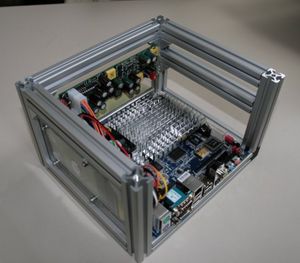PCBricks
A PCBrick is a complete x86-compatible PC, designed for maximum modularity in terms of mechanical construction and data interface provision. It has been designed explicitly for robotic applications, therefore it is fitted with a DC input power supply. The main design goal has been to minimize power consumption while maintaining acceptable performance of the single PCBrick: if more computing power is required, multiple PCBricks can be used. In this way the use of powerful and power-hungry PCs can be confined to the applications where they are really necessary.
The PCBrick design is based on the use of motherboards with mini-ITX form factor (17cm x 17cm). Two types of PCBricks have been built:
- PCBrick v1.0, based on the VIA EN15000 motherboard (single-core VIA C7 processor, clock frequency of 1.5GHz). A PCBrick v1.0 has a power consumption that never exceeds 25W, and is still lower when the processor is not under heavy computational load; on the other hand, its weak point is the low computing power. Don't expect to run software needing heavy computation without hitting the limits of the processor.
- PCBrick v2.0, based on a Jetway J9F2 Extreme motherboard fitted with an Intel Core2 Duo T7200 processor. This is a significantly more powerful machine, both in terms of processing power and of electrical power drawn when heavy computation is required. Horses for courses...
A custom frame has been designed for the PCBrick. It encloses and protects the components of the PCBricks, and at the same time it makes mechanical connections to external structures easy; its "open" nature is ideal for lab work. The PCBrick frame is built from aluminium profiles (we used Item profiles) and 5mm-thick panels (in our case clear acrylic panels, which are cool to look at: but you can choose any non-conducting material). If you want to build your own PCBrick, you can download the specifications of the frame, and the measurements of the panels.
Included in the frame of each PCBrick are a 2.5" hard disk (which, depending on application, can be mechanical or solid-state) and a DC-input power supply accepting from 6V DC to 24V DC. The frame includes the space necessary to fit a PCI card into the (single) slot of the motherboard, and fixtures for mounting additional hardware if required.
Actually, on a PCBrick can be mounted two PCI cards. However, this can only be accomplished by mounting the cards horizontally, and requires the use of an L-shaped PCI adapter board (available). The horizontal mounting of PCI cards can be accomodated by removing from the frame of the PCBrick a pillar, kept in place by a single screw. Note, however, that horizontally-mounted PCI cards will extend out of the PCBrick frame, and that suitable fixing points and protection for them must be realized. Of course the use of the PCI adapter described above also allows for the horizontal mounting of a single PCI card, but it's hard to think of a case in which this kind of mounting is so needed that the awkwardness of having a card sticking out from the PC and needing external fixing points can be overlooked...
In the AIRLab, five PCBricks v1.0 and two PCBricks v2.0 are currently available.
Booting from a USB key or USB disk with a PCBrick v1.0
PCBricks v1.0 are based on the VIA EN15000 motherboard. If you browse through BIOS options, you could conclude that booting from USB is not possible if the boot device is a hard disk or USB key. Actually, it is, although the process to enable that is a bit tricky. Just follow these instructions.
